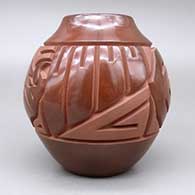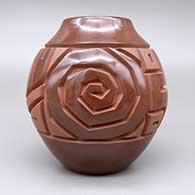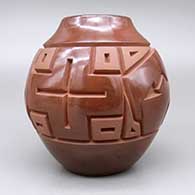
Harrison Begay Jr.
Dineh/Navajo
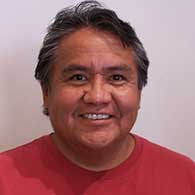
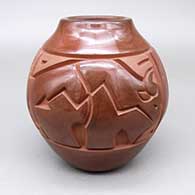
Harrison Begay Jr. was born in the Jeddito Canyon area, near Keams Canyon on the Navajo Nation. He was a painter before he married Marie John of Santa Clara Pueblo and moved to her home there. At Santa Clara, his wife and his mother-in-law taught him the traditional Santa Clara way to make pottery.
Harrison likes to carve his pieces. In the early years of his pottery career he mostly carved typical Santa Clara designs. Then he started carving designs based on the Dineh spiritual pantheon and on petroglyphs he found out in the countryside.
Harrison has earned a number of awards for his work over the years. Lately he's been experimenting with using matte paint on parts of his polished-and-carved pieces and varying his firing effects to deliver different colors of pottery at the end. Harrison has taught his son, Daniel, and his daughter, Jamie, how to make pottery, too.
Some Exhibits that featured Harrison's work
- Crafted to Perfection: the Nancy & Alan Cameros Collection of Southwestern Pottery. Rockwell Museum of Western Art. Corning, New York. November 22, 2007 - May 18, 2008
- Private Reception and Showing: Harrison Begay, Jr. and Daniel Begay. Texas Star Bank. McKinney, Texas. November 24-26, 2006
- American Indian Festival and Market. Dallas, Texas. October 28, 2001
- Native New Mexico, Inc. Santa Fe, New Mexico. August 16, 2001
- Blue Rain Gallery. Chicago, Illinois. March 23-25, 2001
- Grand Opening, David V. Draper Gallery. Santa Fe, New Mexico. June 9, 2000
- Blue Rain Gallery. Ellipse Arts Center. Arlington, Virginia. March 26-28, 1999
- New Works in Clay by Jody Naranjo and Harrison Begay. Faust Gallery. Scottsdale, Arizona. December 4, 1999
- New Works by Hubert Candelario, Linda Tafoya-Oyenque, Russell Sanchez, Harrison Begay. Gallery 10. Scottsdale, Arizona. March 28, 1996
Some Awards Harrison has Won
- 2023 Santa Fe Indian Market, Classification IIC, Category 701 - Carved or incised, black or red, under eight inches, First Place
- 2019 Santa Fe Indian Market, Classification II - Pottery, Division C - Traditional burnished black or red ware, incised, painted or carved, Category 701 - Carved or incised, black or red, under 8": Second Place
- 2019 Heard Museum Guild Indian Art Fair & Market, Classification II - Pottery, Division C - Carved, native clay, hand built, fired out-of-doors: Second Place. Awarded for artwork: "Yei, Hummingbird & Dragonfly"
- 2014 Heard Museum Guild Indian Art Fair & Market, Classification II - Pottery, Division C - Traditional, native clay, hand built, carved: Honorable Mention. Awarded for artwork: "Morning Prayer"
- 2004 Santa Fe Indian Market, Classification II - Pottery, Division C - Traditional pottery, carved or incised, in style of San Juan, San Ildefonso, Santa Clara, Category 1006 - Miscellaneous (can include vases, pitchers, ladles, canteens, boxes, plates, etc.: Third Place
- 2003 Santa Fe Indian Market, Classification II - Pottery, Division C - Traditional pottery, carved or incised, in style of San Juan, San Ildefonso, Santa Clara, Category 1001 - Jars: Second Place
- 2003 Santa Fe Indian Market, Classification II - Pottery, Division C - Traditional pottery, carved or incised, in style of San Juan, San Ildefonso, Santa Clara, Category 1006 - Miscellaneous (can include vases, pitchers, ladles, canteens, boxes, plates: Second Place
- 2001 American Indian Festival and Market, Dallas, Texas, Pottery: Best in Class, First Place and Honorable Mention
- 2001 Santa Fe Indian Market, Classification II - Pottery, Division C - Traditional pottery, carved or incised, jars, Category 1001 - Jars: First Place
- 2001 Santa Fe Indian Market, Classification II - Pottery, Division C - Traditional pottery, carved or incised, jars, Category 1005 - Miscellaneous (can include all vase forms, pitchers, ladles canteens, plates, boxes: Third Place
- 2001 Santa Fe Indian Market: Special Award in Pottery
- 2000 Santa Fe Indian Market, Classification II - Pottery, Division C - Traditional Pottery, carved or incised (in the style of San Juan, San Ildefonso, Santa Clara & other tribal styles), Category 1002 - Jars (over 7" tall): First Place
- 2000 Santa Fe Indian Market, Classification II - Pottery, Division C - Traditional Pottery, carved or incised (in the style of San Juan, San Ildefonso, Santa Clara & other tribal styles), Category 1002 - Jars (over 7" tall): Third Place
- 2000 Heard Museum Guild Indian Fair & Market, Classification VII - Pottery, Division B - Traditional, native clay, hand built, unpainted: Honorable Mention. Awarded for artwork: "Yei (Man and Woman)"
- 1999 Santa Fe Indian Market, Classification II - Pottery, Division C - Traditional Pottery, carved or incised in the style of San Juan, San Ildefonso, Santa Clara & other tribal styles, Category 1001 - Jars (up to 7" tall): First Place
- 1999 Santa Fe Indian Market, Classification II - Pottery, Division C - Traditional Pottery, carved or incised in the style of San Juan, San Ildefonso, Santa Clara & other tribal styles, Category 1002 - Jars (over 7" tall): First Place
- 1999 Santa Fe Indian Market, Classification II - Pottery, Division C - Traditional Pottery, carved or incised in the style of San Juan, San Ildefonso, Santa Clara & other tribal styles, Category 1009 - Miscellaneous, including canteens: Third Place
- 1999 Santa Fe Indian Market, Classification II - Pottery, Division C: Best of Division
- 1998 Santa Fe Indian Market, Classification - Pottery, Division J - Pottery Miniatures, Category 1605 - Traditional forms, other bowls: Third Place
- 1996 Santa Fe Indian Market, Classification II - Pottery, Division C -Traditional pottery, carved or incised in the style of San Juan, San Ildefonso, Santa Clara, other tribal styles, Category 1004 - Bowls (over 7" in diameter): Second Place
- 1996 Santa Fe Indian Market, Classification II - Pottery, Division J - Pottery Miniatures, 3" or less in height or diameter, Category 1605 - Traditional forms, other bowls: First Place
- 1995 Santa Fe Indian Market, Classification II - Pottery, Division D - Traditional pottery, carved, Category 1103 - Bowls (up to 7 inches in diameter): Third Place
- 1995 Santa Fe Indian Market, Classification II - Pottery, Division K - Pottery miniatures, 3" or less in height or diameter, Category 1705 - Traditional forms - other bowls: First Place
100 West San Francisco Street, Santa Fe, New Mexico 87501
(505) 986-1234 - www.andreafisherpottery.com - All Rights Reserved

Santa Clara Pueblo

Ruins at Puye Cliffs, Santa Clara Pueblo
Santa Clara Pueblo straddles the Rio Grande about 25 miles north of Santa Fe. Of all the pueblos, Santa Clara has the largest number of potters.
The ancestral roots of the Santa Clara people have been traced to the pueblos in the Mesa Verde region in southwestern Colorado. When that area began to get dry between about 1100 and 1300, some of the people migrated to the Chama River Valley and constructed Poshuouinge (about 3 miles south of what is now Abiquiu on the edge of the mesa above the Chama River). Eventually reaching two and three stories high with up to 700 rooms on the ground floor, Poshuouinge was inhabited from about 1375 to about 1475. Drought then again forced the people to move, some of them going to the area of Puye (on the eastern slopes of the Pajarito Plateau of the Jemez Mountains) and others to Ohkay Owingeh (San Juan Pueblo, along the Rio Grande). Beginning around 1580, drought forced the residents of the Puye area to relocate closer to the Rio Grande and they founded what we now know as Santa Clara Pueblo on the west bank of the river, between San Juan and San Ildefonso Pueblos.
In 1598 Spanish colonists from nearby Yunque (the seat of Spanish government near San Juan Pueblo) brought the first missionaries to Santa Clara. That led to the first mission church being built around 1622. However, the Santa Clarans chafed under the weight of Spanish rule like the other pueblos did and were in the forefront of the Pueblo Revolt of 1680. One pueblo resident, a mixed black and Tewa man named Domingo Naranjo, was one of the rebellion's ringleaders. When Don Diego de Vargas came back to the area in 1694, he found most of the Santa Clarans on top of nearby Black Mesa (with the people of San Ildefonso). An extended siege didn't subdue them so eventually, the two sides negotiated a treaty and the people returned to their pueblo. However, successive invasions and occupations by northern Europeans took their toll on the tribe over the next 250 years. The Spanish flu pandemic in 1918 almost wiped them out.
Today, Santa Clara Pueblo is home to as many as 2,600 people and they comprise probably the largest per capita number of artists of any North American tribe (estimates of the number of potters run as high as 1-in-4 residents).
Today's pottery from Santa Clara is typically either black or red. It is usually highly polished and designs might be deeply carved or etched ("sgraffito") into the pot's surface. The water serpent, ("avanyu"), is a traditional design motif of Santa Clara pottery. Another motif comes from the legend that a bear helped the people find water during a drought. The bear paw has appeared on their pottery ever since.
One of the reasons for the distinction this pueblo has received is because of the evolving artistry the potters have brought to the craft. Not only did this pueblo produce excellent black and redware, several notable innovations helped move pottery from the realm of utilitarian vessels into the domain of art. Different styles of polychrome redware emerged in the 1920's-1930's. In the early 1960's experiments with stone inlay, incising and double firing began. Modern potters have also extended the tradition with unusual shapes, slips and designs, illustrating what one Santa Clara potter said: "At Santa Clara, being non-traditional is the tradition." (This refers strictly to artistic expression; the method of creating pottery remains traditional).
Santa Clara Pueblo is home to a number of famous pottery families: Tafoya, Baca, Gutierrez, Naranjo, Suazo, Chavarria, Garcia, Vigil, Tapia - to name a few.
100 West San Francisco Street, Santa Fe, New Mexico 87501
(505) 986-1234 - www.andreafisherpottery.com - All Rights Reserved

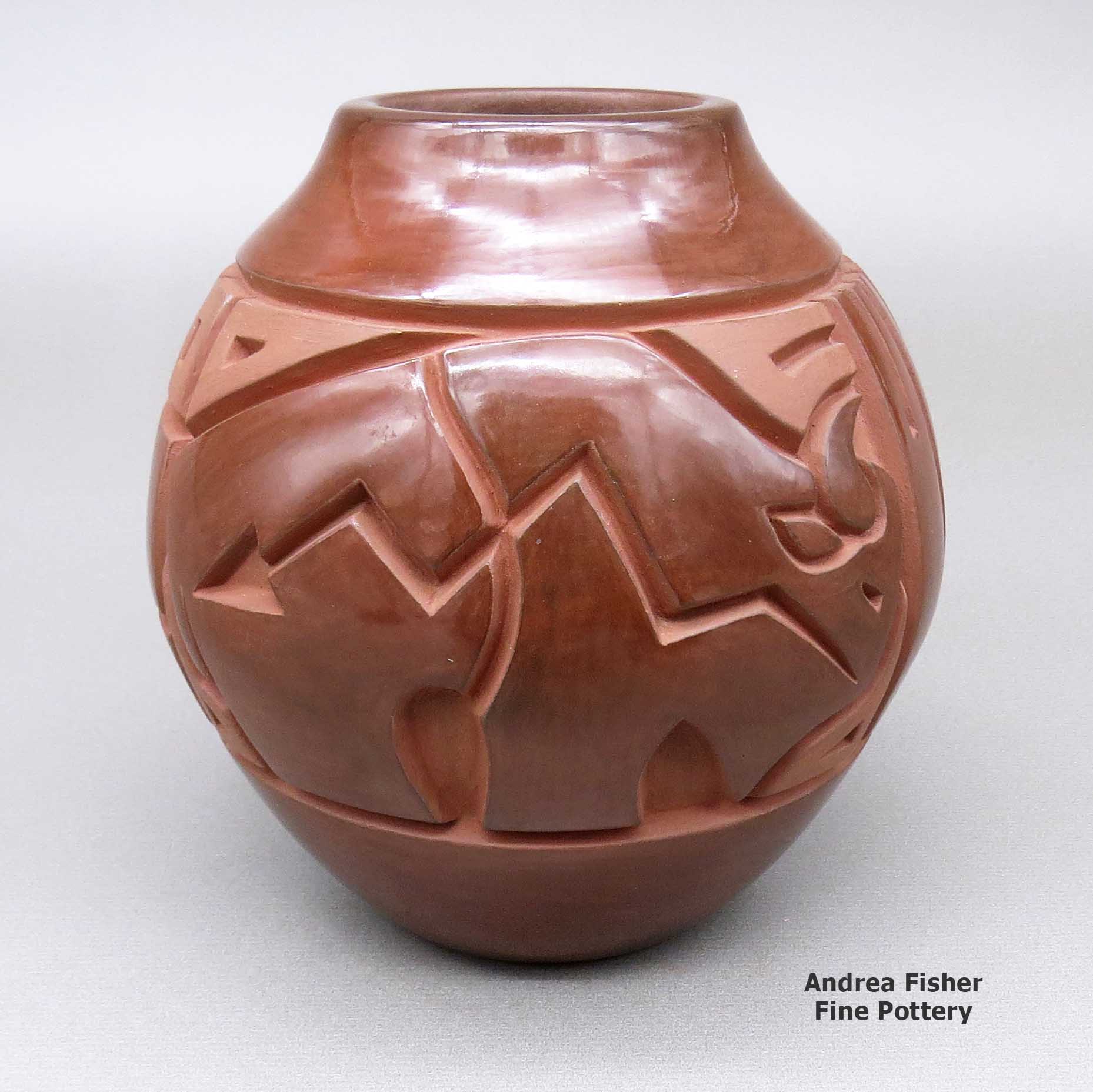
Harrison Begay Jr, Santa_Clara, Redjarwithacarvedbuffalo-with-heart-line,featherring,spiral,andgeometricdesign
Santa Clara
$ 795
chsc4a254
Red jar with a carved buffalo-with-heart-line, feather ring, spiral, and geometric design
4.5 in L by 4.5 in W by 5 in H
Condition: Very good
Signature: Harrison, with jar hallmark and date
Date Created: 2009
100 West San Francisco Street, Santa Fe, New Mexico 87501
(505) 986-1234 - www.andreafisherpottery.com - All Rights Reserved



